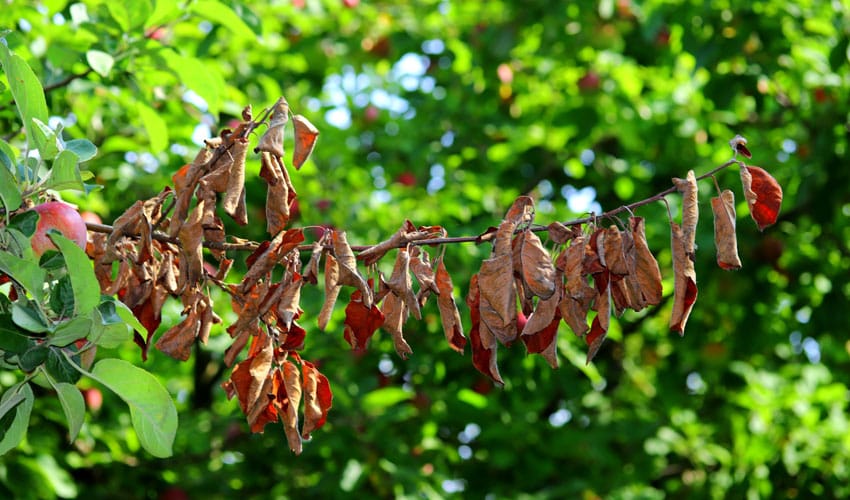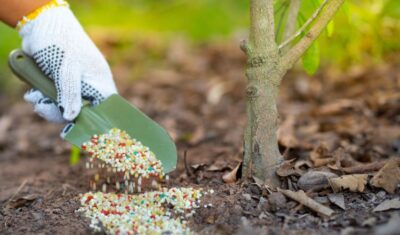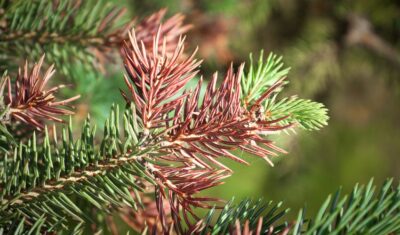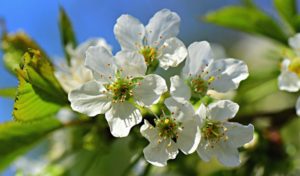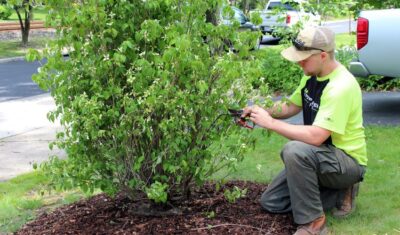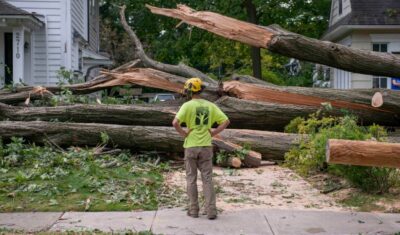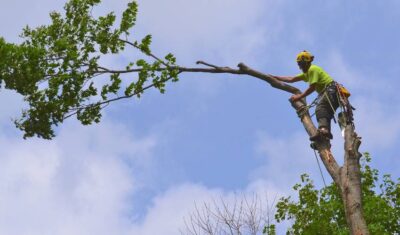If new foliage on your fruit trees or ornamental shrubs looks like it has been torched, or if there are patches of dead foliage and twigs in an otherwise healthy looking tree crown, you might be looking at fire blight. If so, here is important information about the possible cause and what to do about it.
WHAT IS FIRE BLIGHT?
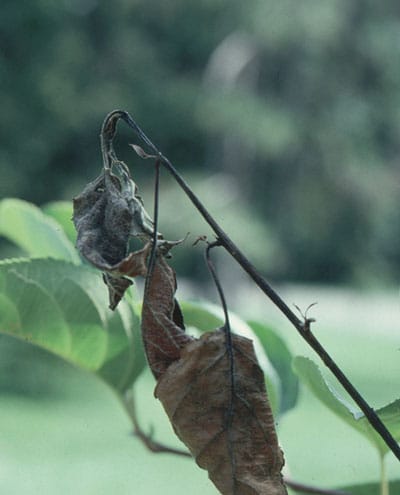
Fire blight symptoms on an apple tree.
Image by Penn State Department of Plant Pathology & Environmental Microbiology Archives, Penn State University, Bugwood.org
Fire blight is a destructive disease caused by a bacterium (Erwinia amylovora) that thrives in the warm, humid, and rainy weather that coincides with the start of the growing season, and it is easily spread.
You can identify fire blight by several characteristics:
- Cankers on a tree’s bark that look like discolored or wet patches, often with areas of dead or decayed sapwood around their edges
- Weeping wounds
- The ends of shoots, twigs, or branches are drooping or dead (they often look like a shepherd’s crook)
- Burnt-looking, dead leaves
- Blighted flowers and fruit that turn brown and decay
- Infected or dead fruiting spurs on branches
HOW DOES Fire blight GET ON MY TREE?
Fire blight spreads throughout a tree and to nearby trees very easily. It’s most commonly spread through:
- Rainfall that splashes bacteria onto nearby leaves, particularly during a hard rain or windy conditions
- Spray irrigation that waters affected trees and shrubs
- Insect damaged leaves and twigs
- Pruning cuts when the cutting blades aren’t disinfected between cuts
- Pollinators that carry the bacteria from flower to flower
Fire blight can also be found in old, mummified fruit that is left on the tree or that falls to the ground.
Once a tree is infected, a single canker can produce millions of bacteria that can spread to nearby susceptible trees and plants.
Although fire blight cankers can overwinter and become active the following spring, it is the new growth and flowers on trees that are most damaged by the bacterium’s rapid springtime spread.
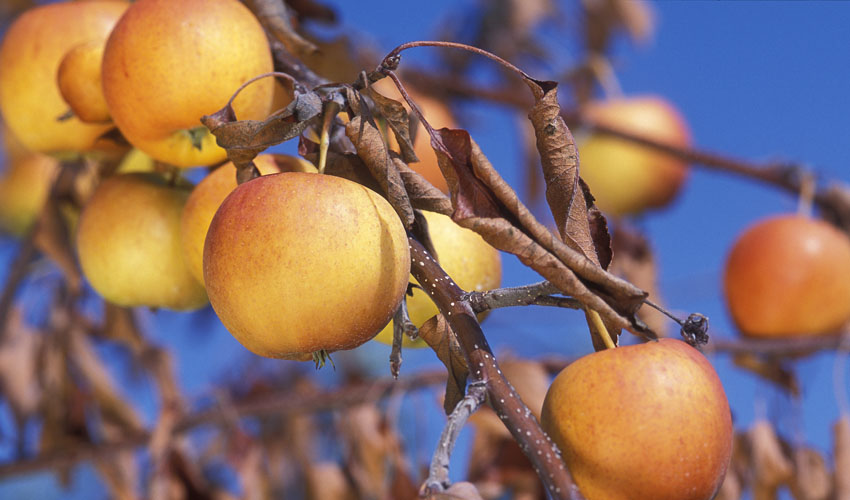
Many types of apple trees are susceptible to fire blight. If you plan to plant an apple tree, look for disease-resistant varieties (see the list later in this article).
WHAT PLANTS GET FIREBLIGHT?
Fire blight affects a lot of plants in the rose family (Rosaeae) which, as you probably guessed, includes roses. The rose family also includes the genera Pyrus (pears) and Prunus. Within the genus Prunus are apples, peaches, cherries, plums, raspberries, and other valuable fruiting crops.
While many species are susceptible, fire blight is especially damaging to apples and pears.
WHAT DO I DO if my tree has fire blight?
First, be certain that the problem has been correctly diagnosed.
If you think your trees have fire blight but aren’t sure, the Certified Arborists at Independent Tree in Newbury, Ohio can help. Give us a call at 440-564-1374; we’re happy to discuss the symptoms or inspect your tree to provide a diagnosis. You’ll learn on the spot what to do and all that is involved in treating fire blight.
Certified Arborists are specially trained to identify and treat tree diseases. Our goal is to be minimally invasive with any treatments and to protect the health of your trees. At the same time, a good professional will be honest about the outcome of all potential treatments.
Treatment Options for Fire Blight
If you want to treat your trees and shrubs yourself, pruning and spraying are the two most common approaches.
Spray Treatments
The anti-bacterial spray that is most widely used is called Bordeaux mixture. It was created in the 19th century in the wine-growing region of France with the same name and has been used ever since. Bordeaux is a mixture of water, copper sulfate, and lime (hydrated lime is calcium hydroxide, not the fruit).
One of the benefits of using Bordeaux mixture rather than a straight copper-based spray is that the Bordeaux mixture sticks to trees during rainy weather while copper sprays wash off. This makes timing your spraying easier because the weather only needs to be clear for as long as it takes the spray to dry.
For a homeowner, there are drawbacks to making and applying the Bordeaux mixture yourself. They include:
- Timing. The full-strength spray is best applied in winter before spring bud break, as it can damage leaves and buds. Dormant season is the usual time to spray, but you can spray a weaker solution in spring to avoid bud damage. For more details, see our article on the proper timing for spring treatments.
- Repetition. You’ll most likely have to spray repeatedly during the year.
- Mixing. To get the most effective spray, you’ll want to mix it just before use. Premixed concentrates are fine but may have sat for some time and become less effective.
- Agitating. You have to keep the ingredients’ particles suspended in water so that they are evenly distributed and do not clog your sprayer’s nozzle.
- Protection. You’ll need to wear a protective breathing mask while making the mixture, and will want to wear protective gear while spraying it. Sulfur = rotten egg smell!
- Application. You need to reach all parts of your trees, which may have reached their mature height and spread. This may be impossible from the ground without special high-pressure equipment.
- Effectiveness. Spraying is not entirely effective, especially when all parts of the tree are not completely drenched during treatment.
Spraying is usually combined with pruning, as spraying prevents new infections but does not cure existing damage.
Pruning Out Diseased Wood
You’ll want to prune out all damaged foliage and branches, disinfecting your pruning tools between each cut, including if you’re pruning in winter. A tool with the fire blight bacterium on it is a perfect vehicle for transferring the disease directly to healthy tree tissue.
Remember that each pruning cut, even those done perfectly, is a wound to the tree. Pruning out fire blight damage during the growing season can leave wounds open to many pathogens that would not be as active during the dormant season. If you do prune, do it as minimally as possible.
Remember to include suckering growth at a trees’ trunk base when pruning, as the graft union (where the variety of tree meets the standard rootstock it was grafted onto) can also be infected by fire blight. Most fruit trees grown in northeast Ohio are grafted onto a hardier rootstock.
Pruning out fire blight generally involves making cuts below the extent of visible canker damage, as the bacterium has almost certainly penetrated internal tissue beyond the edges of the canker. You’ll also want to cut back to the right place on your branches. For details on how and where to cut, see our article on pruning tips.
Other Fire Blight Control Options
Other important measures include reducing fertilization that generates a lot of spring growth that can become infected. If your trees need fertilizing, you can apply a mild, slow-release fertilizer in the fall, or better yet, rely on your well-amended soil and organic layer of mulch (be sure to apply it properly!) to provide sufficient nutrition to your trees.
And always, always remove and discard diseased fruit and fallen debris from the tree or the ground. Place them in a plastic bag, seal it, and dispose with your regular trash. Do not compost diseased material as it’s unlikely to fully kill the fire blight-causing bacteria.
Should you treat fire blight yourself?
Tree care professionals are experienced in treating disease, up to date on best practices for both spraying and pruning, and have the specialized equipment needed to properly apply disease treatments.
If your fire blight is severe, it will be more effective to have it professionally treated. Tree care crews will prune out diseased tissue, spray as needed (during the appropriate timeframe), and remove all infected material from your garden, and can schedule return visits to check on the effectiveness of treatment. This is especially useful if you have full-size, mature apple or pear trees, whose crowns may be 20 feet or more off the ground.
HARD CHOICES
There’s no cure for fire blight, only control.
Sometimes a fire blight infection is so severe that removing the infected tree or trees is the only solution. When infection and internal damage reach a certain point, treatments are no longer effective, and the ease with which fire blight spreads makes infected trees a risk factor for all surrounding trees and plants that are susceptible to fire blight.
The good news is that once an infected tree is removed, its fire blight bacteria are also removed. You can safely plant another apple or pear tree that’s healthy and free of disease and you can specifically choose a fire blight-resistant cultivar! It will take another vector to bring fire blight back to your garden, and small areas of new infections are much easier to control.
Fire Blight Resistant Trees
The table below is taken from Ohio State University Extension.
| Table 3. Relative susceptibility of common apple and pear cultivars to fire blight | ||
| Highly Susceptible | Moderately Susceptible | Moderately Resistant |
| Apple | ||
| Beacon | Dutchess | Jonafree |
| Cortland | Empire | Melrose |
| Fuji | Golden Delicious | Northwestern Greening |
| Gala | Haralson | Nova Easygro |
| Granny Smith | Jonagold | Prima |
| Idared | Jonamac | Priscilla |
| Jonathan | Jerseymac | Quinte |
| Lodi | Liberty | Red Delicious |
| Monroe | McIntosh | Red Free |
| Mutsu (Crispin) | Minjon | Sir Prize |
| Paula Red | Northern Spy | Pristine |
| Rome Beauty | Novamac | Liberty |
| Wayne | Spartan | Goldrush |
| Wealthy | Honeycrisp | Enterprize |
| Yellow Transparent | Braeburn | Sundance |
| Ginger gold | Winsap/Staymen strains | Williams Pride |
| Pear | ||
| Aurora | Maxine | Kieffer |
| Bartlett | Seckel | Magness |
| Bosc | Beurre D’Anjou | Moonglow |
| Clapp’s Favorite | Harrow Delight | |
| Red Bartlett | Honeysweet | |
| Reimer Red | Blake’s Pride | |
| Starkrimson | ||
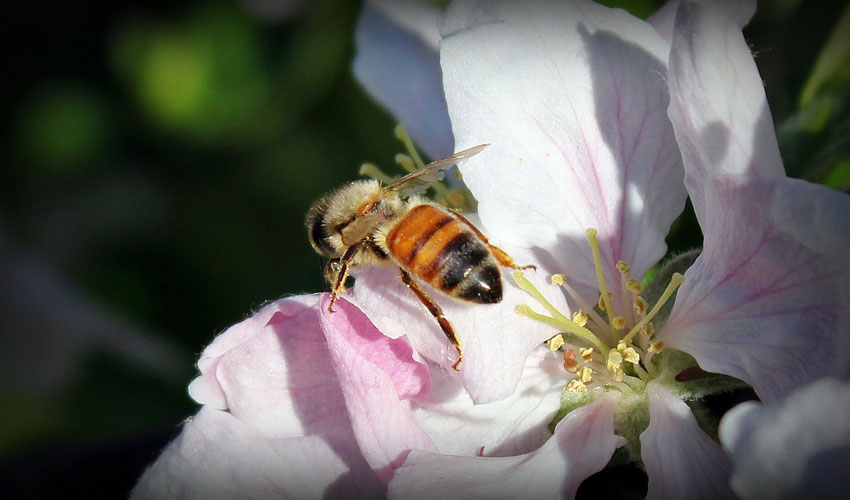
Pollinator bees are important for the health of your fruit trees
Protect Our Pollinators
One very important consideration in the spread and control of fire blight is pollinating bees. Bees can carry fire blight bacteria from flower to flower the same way they carry pollen. Removing flowering fruit trees to control fire blight reduces food sources for bees. On the other hand, keeping untreated or poorly treated diseased trees ensures the spread of fire blight to neighboring trees, resulting in more fruit trees being cut down, further reducing the pollinators’ food sources.
In Summary
Keeping your fruit trees healthy with a proactive tree health care plan is the responsible thing to do. Or, if your trees become infected, treat the outbreak quickly and professionally to minimize damage and prevent spreading fire blight. It’s vital that we keep habitat and food sources for bees healthy, especially when we enjoy the fruits of their labor each year.
Do you have fire blight?
Keeping your fruit trees healthy is the first step in preventing fire blight. Give us a call at 440-564-1374 or contact us online for a complimentary inspection and disease management recommendations.
Schedule a Property Inspection
Contact Independent Tree if you suspect fire blight on your trees or want to prevent it. We can professionally assess your trees and check for any issues.Recent Articles
Topics
About The Author

STAY IN THE LOOP
WITH OUR
LATEST UPDATES
"*" indicates required fields

